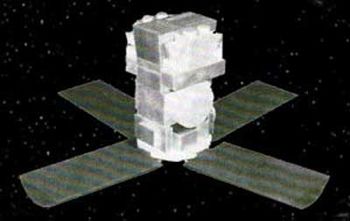
Home - Search - Browse - Alphabetic Index: 0- 1- 2- 3- 4- 5- 6- 7- 8- 9
A- B- C- D- E- F- G- H- I- J- K- L- M- N- O- P- Q- R- S- T- U- V- W- X- Y- Z
SAC-B
 HETE Credit: Manufacturer Image |
AKA: ficas;lite de Aplicaciones CientíSatéSatelite de Aplicaciones Cientificas. Status: Operational 1996. First Launch: 1996-11-04. Last Launch: 1996-11-04. Number: 1 . Gross mass: 181 kg (399 lb). Height: 0.80 m (2.62 ft). Span: 2.10 m (6.80 ft).
The mission was organized as a co-operative effort between the National Aeronautics and Space Administration (NASA) and Argentina's National Commission of Space Activities (CONAE). NASA provided two scientific instruments and launch services on a Pegasus XL vehicle. CONAE was responsible for the design and construction of the SAC-B satellite.
SAC-B was three axis stabilized, using two momentum wheels in a "V" configuration for roll and yaw control. Pitch axis control and momentum unloading was accomplished using magnetic torque coils. Coarse and fine sun sensors, combined with magnetometer readings provided spacecraft attitude knowledge. Four GaAs solar panels produced a total of 256 W (beginning of life) to run spacecraft instruments and charged two 10 A-h NiCd batteries. Command and data handling was performed using redundant 80C86 processors with 64 Kbytes of EEPROM, 64 Kbytes of program RAM and 64 Kbytes of data RAM. Telemetry was formatted and stored in a 2 Mbit mass memory for downlink at 50, 100, or 200 kbps using 5W S-band transmitters. The mission control ground station was located in Buenos Aires, Argentina, with initial orbit and backup support provided by NASA Wallops and DSN stations.
The SAC-B science objectives were supported by four instrument groups:
The Hard X-Ray Spectrometer (HXRS) provided by the Argentine Institute of Astronomy and Space Physics (IAFE) was to have searched the hard X-ray spectrum between 20 and 320 keV of rapidly varying events on time scales as short as tens of milliseconds.
The Goddard X-Ray Experiment (GXRE) provided by NASA/Goddard Space Flight Centre (GSFC) had two sets of detectors. One of them, the Soft X-Ray Spectro-meter (SOXS), was to have performed coordinated observations with the HXRS by observing soft X-ray emissions from solar flares. The other, the Gamma Ray Burst Spectrometer (GRaBS) was to have provided time profiles of the X-ray emission from non-solar gamma-ray bursts in the energy range from ~20 keV to > 300 keV.
The Cosmic Unresolved X-Ray Background Instrument using CCDs (CUBIC) was provided by the Pennsylvania State University. CUBIC was to have measured the spectrum of the diffuse X-Ray background with unprecedented sensitivity and spectral resolution between 0.1 and 10.0 keV in selected areas of the sky.
The Imaging Particle Spectrometer for Energetic Neutral Atoms (ISENA), provided by the Italian Istituto di Fisica dello Spazio Interplanetario (IFSI), was to have measured neutral atoms at spacecraft altitudes.
SAC-B was launched with HETE on a Pegasus XL on 4 November 1996, which achieved a nominal orbit but did not eject the satellite due to a Pegasus transient power bus failure. The system flew with SAC-B, HETE and the Pegasus third stage connected together as a single 650 kg object. SAC-B deployed its solar panels successfully and operated for about 10 hours. On-board software was modified to permit operation without a separation indication and the ACS system was placed in safe-hold mode in an attempt to gain control and point the solar panels at the sun. However, the ACS system was not designed to control such a massive tumbling object. With the Pegasus third stage shadowing part or all of the solar array, there was not enough power to charge the batteries, even during the daylight part of the orbit. At the last contact, battery power continued to decrease, and four subsequent passes over Wallops did not produce any signal from the satellite. Because the SAC-B/HETE/Pegasus object was so long, it would eventually stabilize in a gravity-gradient capture mode, although it would probably take a long time for it to lose its existing angular momentum. It could be captured in either orientation: SAC-B up or SAC-B down. In any event, it was unlikely that spacecraft control would be regained.
Pegasus XL's launch failure represented a $ 14 million loss for the booster, $ 26 million for HETE and $ 21.5 million for SAC-B.
Electric System: 0.256 average kW.
More at: SAC-B.
Family: Medium earth orbit, Solar, Technology. Country: Argentina. Launch Vehicles: Pegasus, Pegasus XL. Projects: SAC. Launch Sites: Wallops Island DZ. Agency: NASA, CONAE, INVAP. Bibliography: 2, 4, 13046.
1996 November 4 - . 17:08 GMT - . Launch Site: Wallops Island. Launch Complex: Wallops Island DZ. Launch Pad: RW04/22. Launch Platform: L-1011. LV Family: Pegasus. Launch Vehicle: Pegasus XL. FAILURE: The rocket functioned perfectly but the separation system failed to release the payload..
- SAC-B - . Nation: Argentina. Agency: CONAE. Program: SAC. Class: Technology. Type: Navigation technology satellite. Spacecraft: SAC-B. Decay Date: 2002-04-07 . USAF Sat Cat: 24645 . COSPAR: 1996-061A. Apogee: 555 km (344 mi). Perigee: 487 km (302 mi). Inclination: 38.00 deg. Period: 95.00 min. Air dropped in Wallops Island DZ..
Back to top of page
Home - Search - Browse - Alphabetic Index: 0- 1- 2- 3- 4- 5- 6- 7- 8- 9
A- B- C- D- E- F- G- H- I- J- K- L- M- N- O- P- Q- R- S- T- U- V- W- X- Y- Z
© 1997-2019 Mark Wade - Contact
© / Conditions for Use